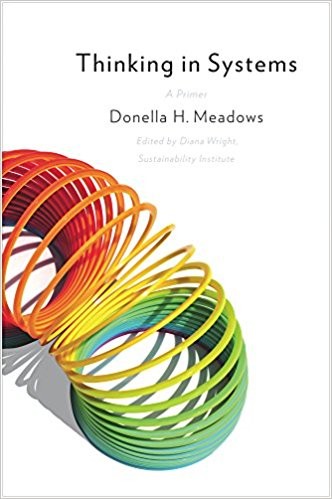nicknicknicknick reviewed Thinking in systems by Donella H. Meadows
Review of 'Thinking in systems' on Goodreads
3 stars
1) "A system is a set of things---people, cells, molecules, or whatever---interconnected in such a way that they produce their own pattern of behavior over time. The system may be buffeted, constricted, triggered, or driven by outside forces. But the system's response to these forces is characteristic of itself, and that response is seldom simple in the real world."
2) "We are less likely to be surprised if we can see how events accumulate into dynamic patterns of behavior. The team is on a winning streak. The variance of the river is increasing, with higher floodwaters during rains and lower flows during droughts. The Dow has been trending up for two years. Discoveries of oil are becoming less frequent. The felling of forests is happening at an ever-increasing rate.
The behavior of a system is its performance over time---its growth, stagnation, decline, oscillation, randomness, or evolution. If the news did a better job of putting events into historical context, we would have better behavior-level understanding, which is deeper than event-level understanding. When a systems thinker encounters a problem, the first thing he or she does is look for data, time graphs, the history of the system. That's because long-term behavior provides clues to the underlying system structure. And structure is the key to understanding not just what is happening, but why."
3) "Clouds [in systems diagrams] stand for the beginnings and ends of flows. They are stocks---sources and sinks---that are being ignored at the moment for the purposes of simplifying the present discussion. They mark the boundary of the system diagram. They rarely mark a real boundary, because systems rarely have real boundaries. Everything, as they say, is connected to everything else, and not neatly. There is no clearly determinable boundary between the sea and the land, between sociology and anthropology, between an automobile's exhaust and your nose. There are only boundaries of word, thought, perception, and social agreement---artificial, mental-model boundaries.
The greatest complexities arise exactly at boundaries. There are Czechs on the German side of the border and Germans on the Czech side of the border. Forest species extend beyond the edge of the forest into the field; field species penetrate partway into the forest. Disorderly, mixed-up borders are sources of diversity and creativity."
4) "Some people think the fall of the communist Soviet Union has disproved the theories of Karl Marx, but this particular analysis of his---that market competition systematically eliminates market competition---is demonstrated wherever there is, or used to be, a competitive market. Because of the reinforcing feedback loop of success to the successful, the many automobile companies in the United States were reduced to three (not one, because of antitrust laws). In most major U.S. cities, there is only one newspaper left. In every market economy, we see long-term trends of declining numbers of farms, while the size of farms increases."
5) "There is yet one leverage point that is even higher than changing a paradigm. That is to keep oneself unattached in the arena of paradigms, to stay flexible, to realise that no paradigm is "true," that every one, including the one that sweetly shapes your own worldview, is a tremendously limited understanding of an immense and amazing universe that is far beyond human comprehension. It is to "get" at a gut level the paradigm that there are paradigms, and to see that that itself is a paradigm, and to regard that whole realization as devastatingly funny. It is to let go into not-knowing, into what the Buddhists call enlightenment."

